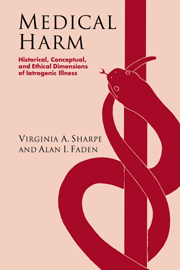4 - The moral basis of medicine: why ‘do no harm’?
Published online by Cambridge University Press: 22 September 2009
Summary
The literature on iatrogenic illness is replete with references to the Hippocratic injunction against harming patients. The cardinal tenet, of medicine, says R. L. Kane is primum non nocere. R. P. Ferguson observes that, ‘The sense of nonmaleficence goes back to the oath of Hippocrates and is, of course, encapsulated in our quintessential maxim: first do no harm’. In a study on the ‘frequency and morbidity of invasive procedures’, Schroeder, et al. advise that, ‘The stricture that physicians first, do not harm mandates scrupulous avoidance of procedures in which possible results do not justify risks involved’. Walco et al., in a recent paper on ‘The ethics of pain control in infants and children’ state that ‘The fundamental principle of responsible medical care is … do no harm’. Despite its almost universal endorsement, we have seen that the obligation to do no harm has been interpreted relative to historical circumstance and the value commitments of individuals and institutions. In the nineteenth and early twentieth centuries we saw the obligation strained by the professionalization of medicine. In many ways, the physician's loyalty was divided between preventing harm to the profession and preventing harm to the patient. This tension was induced and exacerbated by key institutions – medical schools, hospitals, and the American Medical Association (AMA). Also during this period, the grounding of medical epistemology in experimental science served to divert attention from the patient's particularity to the more general manifestations of disease.
- Type
- Chapter
- Information
- Medical HarmHistorical, Conceptual and Ethical Dimensions of Iatrogenic Illness, pp. 81 - 99Publisher: Cambridge University PressPrint publication year: 1998



